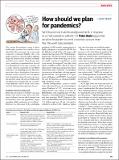How should we plan for pandemics?
Author(s)
Doshi, Peter
DownloadDoshi-2009-How should we plan for pandemics.pdf (420.8Kb)
PUBLISHER_POLICY
Publisher Policy
Article is made available in accordance with the publisher's policy and may be subject to US copyright law. Please refer to the publisher's site for terms of use.
Terms of use
Metadata
Show full item recordAbstract
WHO has revised its definition of pandemic flu in response to current experience with A/H1N1. Peter Doshi argues that our plans for pandemics need to take into account more than the worst case scenarios
The current flu pandemic raises a public health policy question that could have been asked after the emergence of severe acute respiratory syndrome (SARS): what is the proper response to clinically mild or epidemiologically limited (small number) outbreaks caused by new viruses? Over the past four years, pandemic preparations have focused on responding to worst case scenarios. As a result, officials responded to the H1N1 outbreak as an unfolding disaster. Measures were taken that in hindsight may be seen as alarmist, overly restrictive, or even unjustified. Assumptions about the nature of emerging infections along with advanced laboratory surveillance have changed the way we understand epidemics and we need a new framework for thinking about epidemic disease.
Date issued
2009-09Department
Massachusetts Institute of Technology. Program in History, Anthropology, and Science, Technology, and SocietyJournal
BMJ: British Medical Journal
Publisher
BMJ Publishing Group, Ltd.
Citation
Doshi, Peter. “Calibrated response to emerging infections.” BMJ 2009;339:b3471 © 2009 BMJ Publishing Group Ltd.
Version: Final published version
ISSN
0959-8146
0959-8138